Siamak Shakeri
Capabilities of Gemini Models in Medicine
May 01, 2024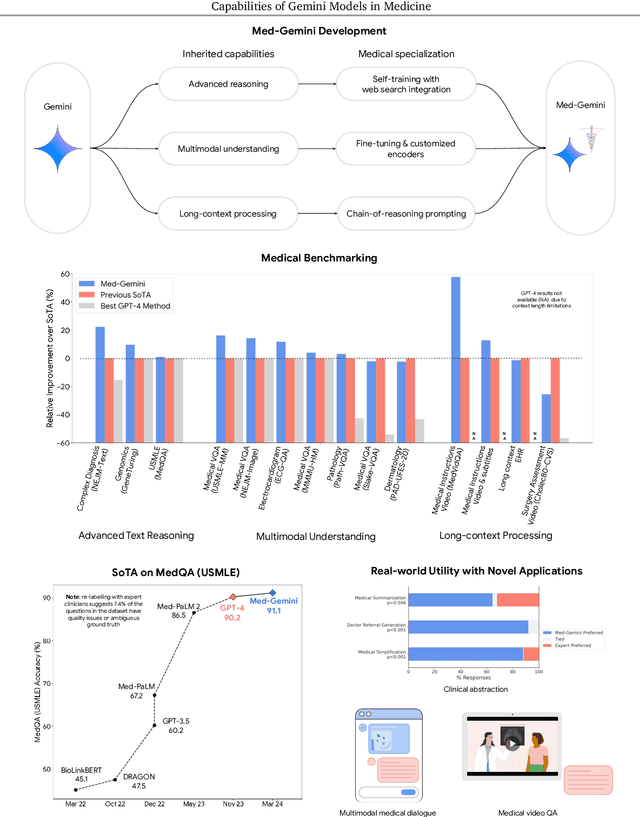

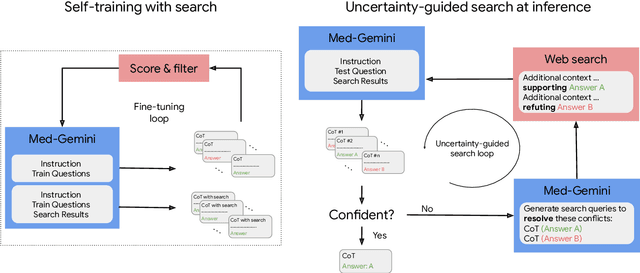

Abstract:Excellence in a wide variety of medical applications poses considerable challenges for AI, requiring advanced reasoning, access to up-to-date medical knowledge and understanding of complex multimodal data. Gemini models, with strong general capabilities in multimodal and long-context reasoning, offer exciting possibilities in medicine. Building on these core strengths of Gemini, we introduce Med-Gemini, a family of highly capable multimodal models that are specialized in medicine with the ability to seamlessly use web search, and that can be efficiently tailored to novel modalities using custom encoders. We evaluate Med-Gemini on 14 medical benchmarks, establishing new state-of-the-art (SoTA) performance on 10 of them, and surpass the GPT-4 model family on every benchmark where a direct comparison is viable, often by a wide margin. On the popular MedQA (USMLE) benchmark, our best-performing Med-Gemini model achieves SoTA performance of 91.1% accuracy, using a novel uncertainty-guided search strategy. On 7 multimodal benchmarks including NEJM Image Challenges and MMMU (health & medicine), Med-Gemini improves over GPT-4V by an average relative margin of 44.5%. We demonstrate the effectiveness of Med-Gemini's long-context capabilities through SoTA performance on a needle-in-a-haystack retrieval task from long de-identified health records and medical video question answering, surpassing prior bespoke methods using only in-context learning. Finally, Med-Gemini's performance suggests real-world utility by surpassing human experts on tasks such as medical text summarization, alongside demonstrations of promising potential for multimodal medical dialogue, medical research and education. Taken together, our results offer compelling evidence for Med-Gemini's potential, although further rigorous evaluation will be crucial before real-world deployment in this safety-critical domain.
Gemma: Open Models Based on Gemini Research and Technology
Mar 13, 2024



Abstract:This work introduces Gemma, a family of lightweight, state-of-the art open models built from the research and technology used to create Gemini models. Gemma models demonstrate strong performance across academic benchmarks for language understanding, reasoning, and safety. We release two sizes of models (2 billion and 7 billion parameters), and provide both pretrained and fine-tuned checkpoints. Gemma outperforms similarly sized open models on 11 out of 18 text-based tasks, and we present comprehensive evaluations of safety and responsibility aspects of the models, alongside a detailed description of model development. We believe the responsible release of LLMs is critical for improving the safety of frontier models, and for enabling the next wave of LLM innovations.
Gemini 1.5: Unlocking multimodal understanding across millions of tokens of context
Mar 08, 2024Abstract:In this report, we present the latest model of the Gemini family, Gemini 1.5 Pro, a highly compute-efficient multimodal mixture-of-experts model capable of recalling and reasoning over fine-grained information from millions of tokens of context, including multiple long documents and hours of video and audio. Gemini 1.5 Pro achieves near-perfect recall on long-context retrieval tasks across modalities, improves the state-of-the-art in long-document QA, long-video QA and long-context ASR, and matches or surpasses Gemini 1.0 Ultra's state-of-the-art performance across a broad set of benchmarks. Studying the limits of Gemini 1.5 Pro's long-context ability, we find continued improvement in next-token prediction and near-perfect retrieval (>99%) up to at least 10M tokens, a generational leap over existing models such as Claude 2.1 (200k) and GPT-4 Turbo (128k). Finally, we highlight surprising new capabilities of large language models at the frontier; when given a grammar manual for Kalamang, a language with fewer than 200 speakers worldwide, the model learns to translate English to Kalamang at a similar level to a person who learned from the same content.
Gemini: A Family of Highly Capable Multimodal Models
Dec 19, 2023Abstract:This report introduces a new family of multimodal models, Gemini, that exhibit remarkable capabilities across image, audio, video, and text understanding. The Gemini family consists of Ultra, Pro, and Nano sizes, suitable for applications ranging from complex reasoning tasks to on-device memory-constrained use-cases. Evaluation on a broad range of benchmarks shows that our most-capable Gemini Ultra model advances the state of the art in 30 of 32 of these benchmarks - notably being the first model to achieve human-expert performance on the well-studied exam benchmark MMLU, and improving the state of the art in every one of the 20 multimodal benchmarks we examined. We believe that the new capabilities of Gemini models in cross-modal reasoning and language understanding will enable a wide variety of use cases and we discuss our approach toward deploying them responsibly to users.
Triggering Multi-Hop Reasoning for Question Answering in Language Models using Soft Prompts and Random Walks
Jun 06, 2023Abstract:Despite readily memorizing world knowledge about entities, pre-trained language models (LMs) struggle to compose together two or more facts to perform multi-hop reasoning in question-answering tasks. In this work, we propose techniques that improve upon this limitation by relying on random walks over structured knowledge graphs. Specifically, we use soft prompts to guide LMs to chain together their encoded knowledge by learning to map multi-hop questions to random walk paths that lead to the answer. Applying our methods on two T5 LMs shows substantial improvements over standard tuning approaches in answering questions that require 2-hop reasoning.
PaLI-X: On Scaling up a Multilingual Vision and Language Model
May 29, 2023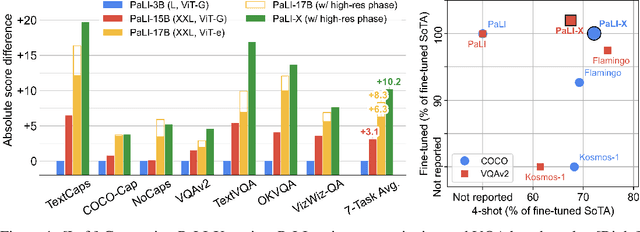

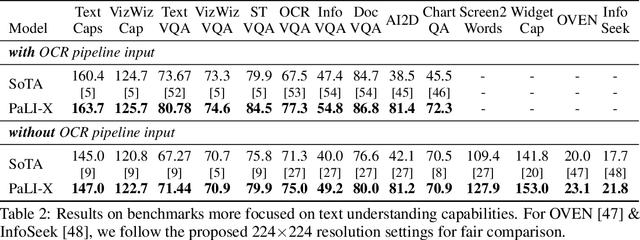
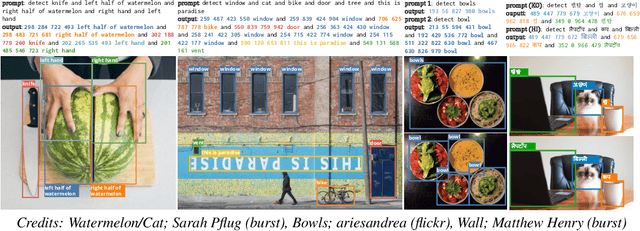
Abstract:We present the training recipe and results of scaling up PaLI-X, a multilingual vision and language model, both in terms of size of the components and the breadth of its training task mixture. Our model achieves new levels of performance on a wide-range of varied and complex tasks, including multiple image-based captioning and question-answering tasks, image-based document understanding and few-shot (in-context) learning, as well as object detection, video question answering, and video captioning. PaLI-X advances the state-of-the-art on most vision-and-language benchmarks considered (25+ of them). Finally, we observe emerging capabilities, such as complex counting and multilingual object detection, tasks that are not explicitly in the training mix.
Brainformers: Trading Simplicity for Efficiency
May 29, 2023Abstract:Transformers are central to recent successes in natural language processing and computer vision. Transformers have a mostly uniform backbone where layers alternate between feed-forward and self-attention in order to build a deep network. Here we investigate this design choice and find that more complex blocks that have different permutations of layer primitives can be more efficient. Using this insight, we develop a complex block, named Brainformer, that consists of a diverse sets of layers such as sparsely gated feed-forward layers, dense feed-forward layers, attention layers, and various forms of layer normalization and activation functions. Brainformer consistently outperforms the state-of-the-art dense and sparse Transformers, in terms of both quality and efficiency. A Brainformer model with 8 billion activated parameters per token demonstrates 2x faster training convergence and 5x faster step time compared to its GLaM counterpart. In downstream task evaluation, Brainformer also demonstrates a 3% higher SuperGLUE score with fine-tuning compared to GLaM with a similar number of activated parameters. Finally, Brainformer largely outperforms a Primer dense model derived with NAS with similar computation per token on fewshot evaluations.
PaLM 2 Technical Report
May 17, 2023



Abstract:We introduce PaLM 2, a new state-of-the-art language model that has better multilingual and reasoning capabilities and is more compute-efficient than its predecessor PaLM. PaLM 2 is a Transformer-based model trained using a mixture of objectives. Through extensive evaluations on English and multilingual language, and reasoning tasks, we demonstrate that PaLM 2 has significantly improved quality on downstream tasks across different model sizes, while simultaneously exhibiting faster and more efficient inference compared to PaLM. This improved efficiency enables broader deployment while also allowing the model to respond faster, for a more natural pace of interaction. PaLM 2 demonstrates robust reasoning capabilities exemplified by large improvements over PaLM on BIG-Bench and other reasoning tasks. PaLM 2 exhibits stable performance on a suite of responsible AI evaluations, and enables inference-time control over toxicity without additional overhead or impact on other capabilities. Overall, PaLM 2 achieves state-of-the-art performance across a diverse set of tasks and capabilities. When discussing the PaLM 2 family, it is important to distinguish between pre-trained models (of various sizes), fine-tuned variants of these models, and the user-facing products that use these models. In particular, user-facing products typically include additional pre- and post-processing steps. Additionally, the underlying models may evolve over time. Therefore, one should not expect the performance of user-facing products to exactly match the results reported in this report.
Generative Models for 3D Point Clouds
Feb 26, 2023



Abstract:Point clouds are rich geometric data structures, where their three dimensional structure offers an excellent domain for understanding the representation learning and generative modeling in 3D space. In this work, we aim to improve the performance of point cloud latent-space generative models by experimenting with transformer encoders, latent-space flow models, and autoregressive decoders. We analyze and compare both generation and reconstruction performance of these models on various object types.
Characterizing Attribution and Fluency Tradeoffs for Retrieval-Augmented Large Language Models
Feb 14, 2023Abstract:Despite recent progress, it has been difficult to prevent semantic hallucinations in generative Large Language Models. One common solution to this is augmenting LLMs with a retrieval system and making sure that the generated output is attributable to the retrieved information. Given this new added constraint, it is plausible to expect that the overall quality of the output will be affected, for example, in terms of fluency. Can scaling language models help? Here we examine the relationship between fluency and attribution in LLMs prompted with retrieved evidence in knowledge-heavy dialog settings. Our experiments were implemented with a set of auto-metrics that are aligned with human preferences. They were used to evaluate a large set of generations, produced under varying parameters of LLMs and supplied context. We show that larger models tend to do much better in both fluency and attribution, and that (naively) using top-k retrieval versus top-1 retrieval improves attribution but hurts fluency. We next propose a recipe that could allow smaller models to both close the gap with larger models and preserve the benefits of top-k retrieval while avoiding its drawbacks.
 Add to Chrome
Add to Chrome Add to Firefox
Add to Firefox Add to Edge
Add to Edge